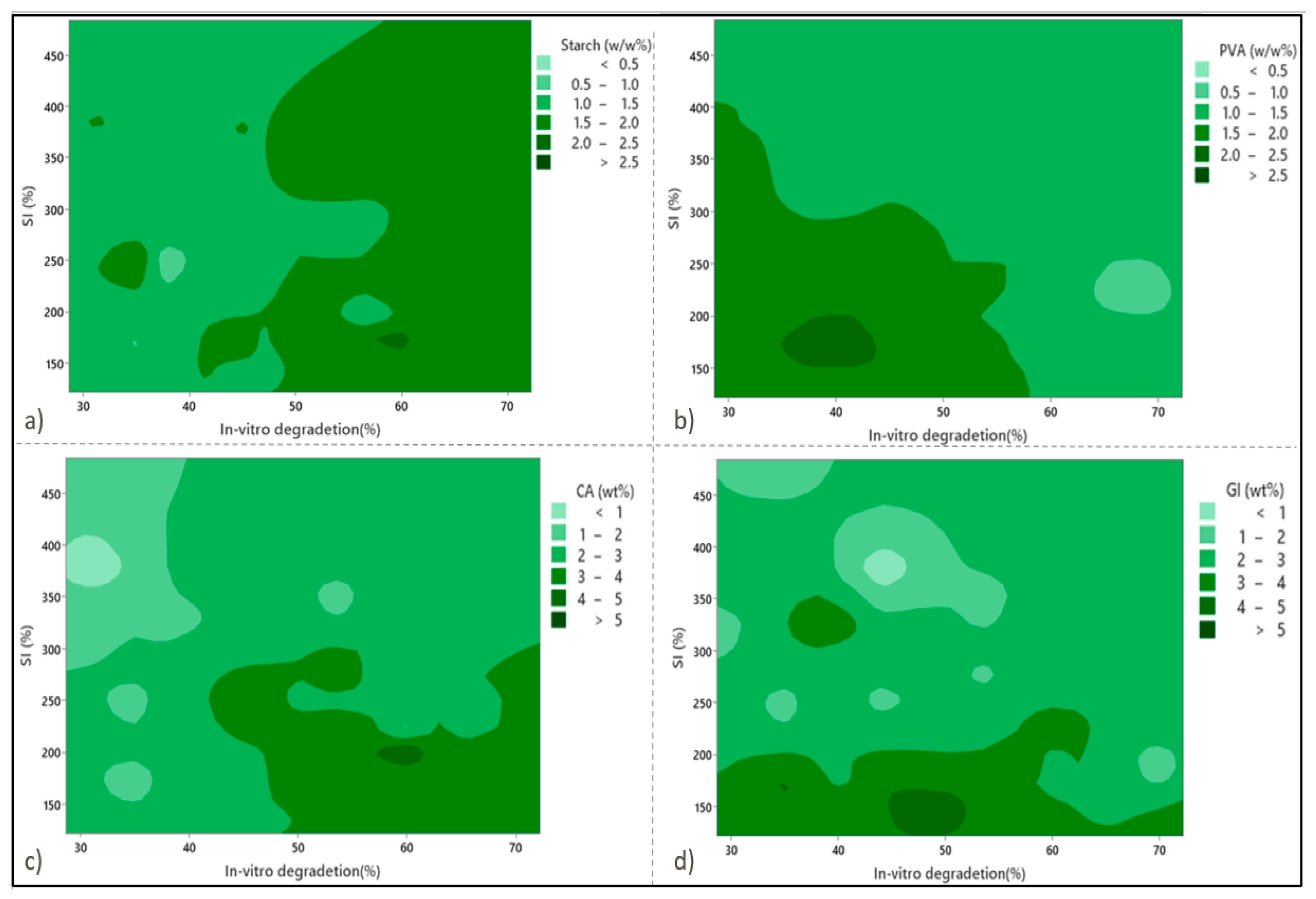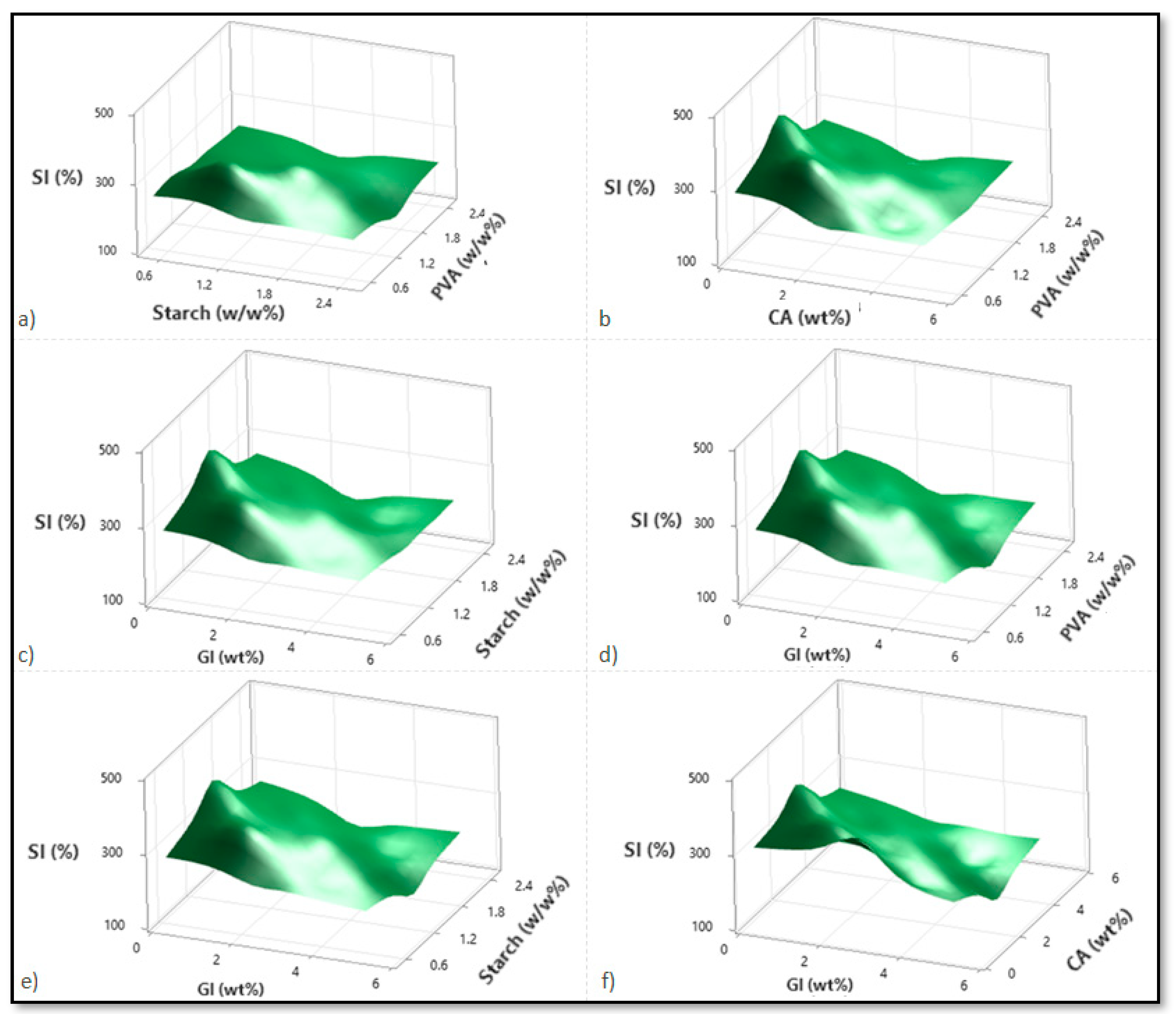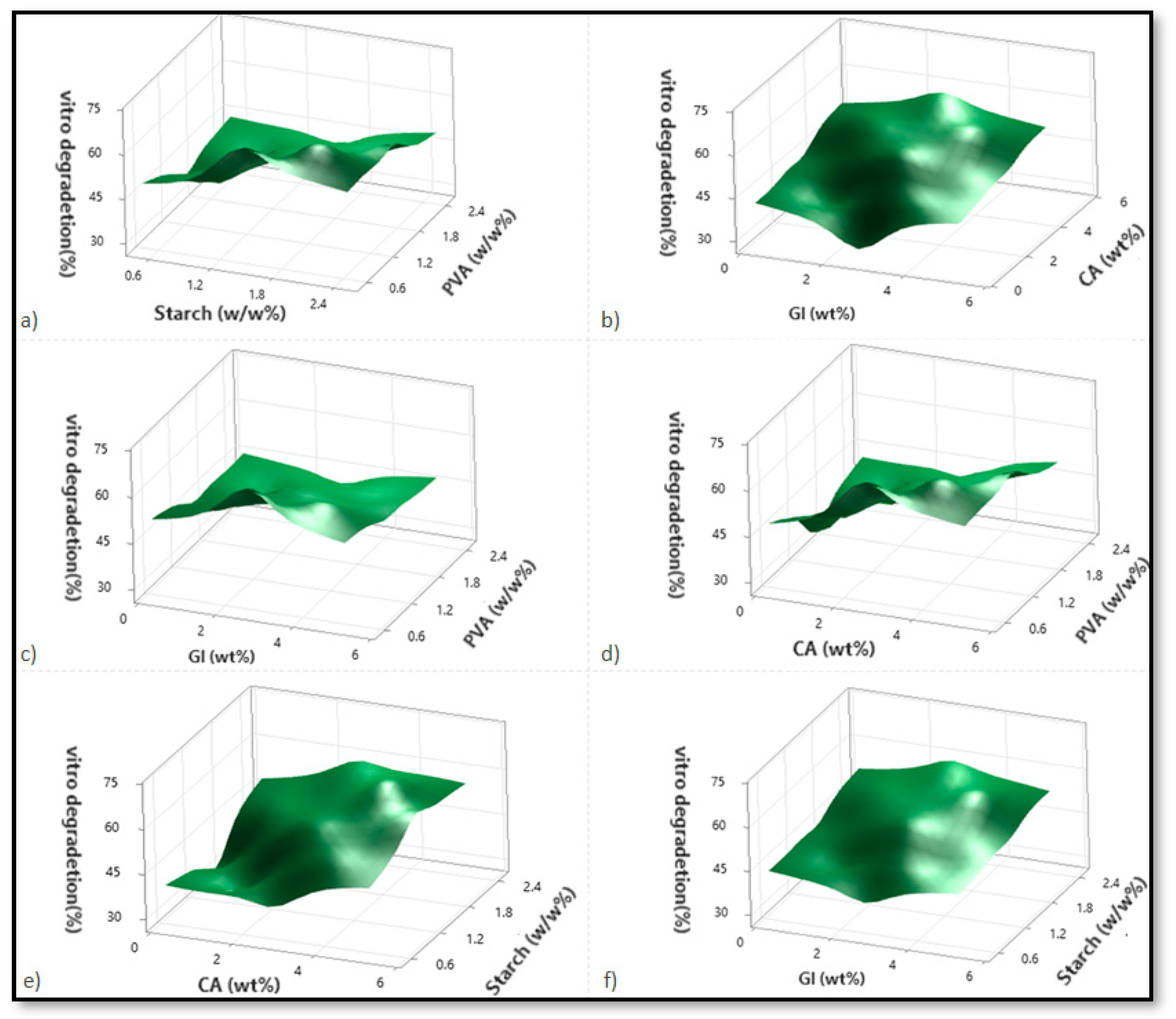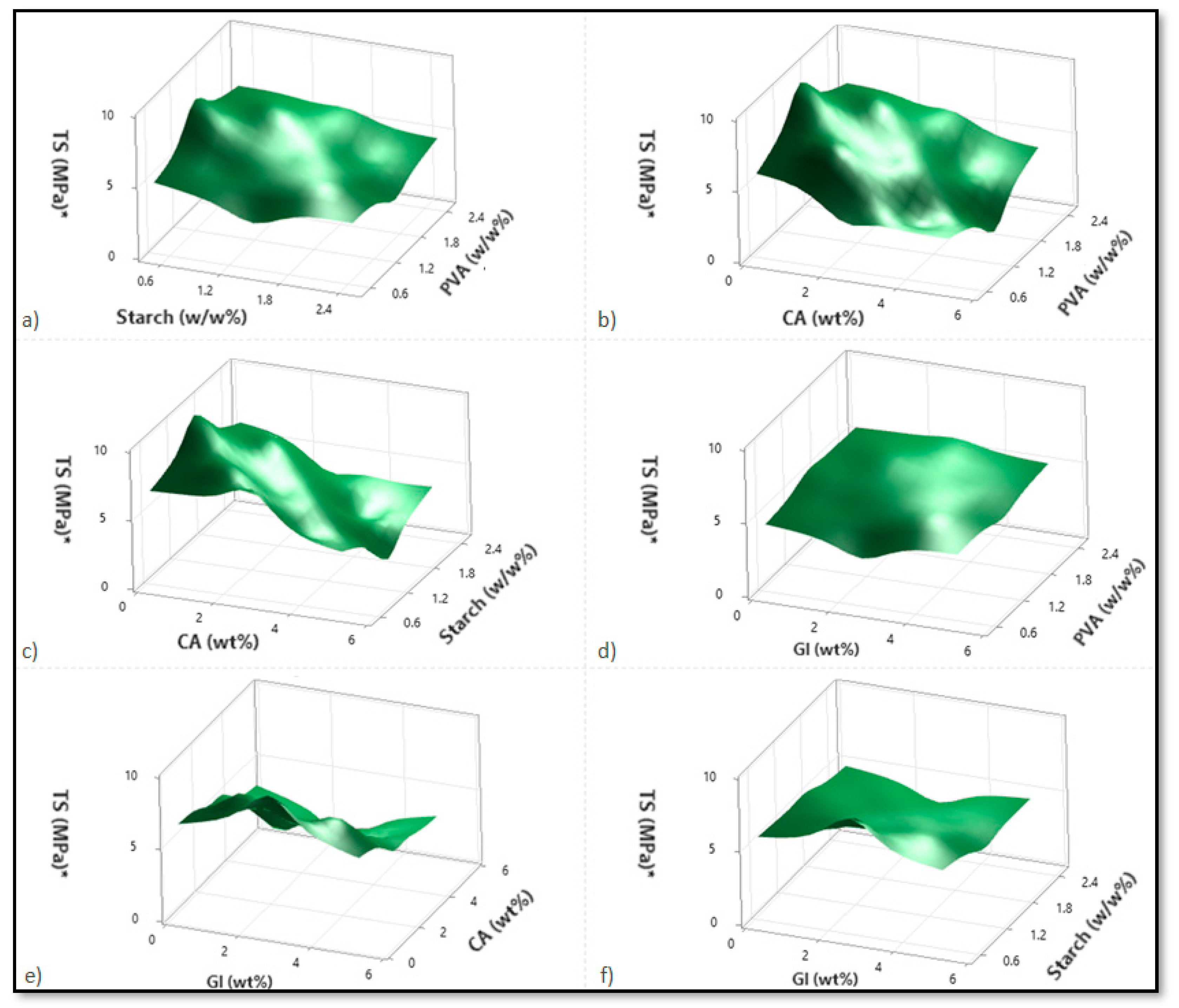Optimizing Biodegradable Starch-Based Composite Films Formulation for Wound-Dressing Applications
Abstract
:1. Introduction
2. Materials and Methods
2.1. Materials
2.2. Preparation of the Films
2.3. Design and Analysis of the Experiments
2.4. Swelling Index
2.5. Weight Loss
2.6. Mechanical Strength
3. Results
3.1. Swelling Index
3.2. In Vitro Degradation
3.3. Mechanical Strength
3.4. Response Surface Graphs
4. Discussion
5. Conclusions
Author Contributions
Funding
Data Availability Statement
Conflicts of Interest
References
- Mittal, A.; Garg, S.; Kohli, D.; Maiti, M.; Jana, A.K.; Bajpai, S. Effect of cross linking of PVA/starch and reinforcement of modified barley husk on the properties of composite films. Carbohydr. Polym. 2016, 151, 926–938. [Google Scholar] [CrossRef] [PubMed]
- Das, A.; Uppaluri, R.; Das, C. Feasibility of poly-vinyl alcohol/starch/glycerol/citric acid composite films for wound dressing applications. Int. J. Biol. Macromol. 2019, 131, 998–1007. [Google Scholar] [CrossRef] [PubMed]
- Delavari, M.M.; Stiharu, I. Preparation and Characterization of Eco-Friendly Transparent Antibacterial Starch/Polyvinyl Alcohol Materials for Use as Wound-Dressing. Micromachines 2022, 13, 960. [Google Scholar] [CrossRef] [PubMed]
- Kamoun, E.A.; Chen, X.; Eldin, M.S.M.; Kenawy, E.-R.S. Crosslinked poly (vinyl alcohol) hydrogels for wound dressing applications: A review of remarkably blended polymers. Arab. J. Chem. 2015, 8, 1–14. [Google Scholar] [CrossRef] [Green Version]
- Kamoun, E.A.; Kenawy, E.-R.S.; Chen, X. A review on polymeric hydrogel membranes for wound dressing applications: PVA-based hydrogel dressings. J. Adv. Res. 2017, 8, 217–233. [Google Scholar] [CrossRef]
- Torres, F.G.; Commeaux, S.; Troncoso, O.P. Starch-based biomaterials for wound-dressing applications. Starch-Stärke 2013, 65, 543–551. [Google Scholar] [CrossRef]
- Mogoşanu, G.D.; Grumezescu, A.M. Natural and synthetic polymers for wounds and burns dressing. Int. J. Pharm. 2014, 463, 127–136. [Google Scholar] [CrossRef]
- Shi, R.; Bi, J.; Zhang, Z.; Zhu, A.; Chen, D.; Zhou, X.; Zhang, L.; Tian, W. The effect of citric acid on the structural properties and cytotoxicity of the polyvinyl alcohol/starch films when molding at high temperature. Carbohydr. Polym. 2008, 74, 763–770. [Google Scholar] [CrossRef]
- Shi, R.; Zhu, A.; Chen, D.; Jiang, X.; Xu, X.; Zhang, L.; Tian, W. In vitro degradation of starch/PVA films and biocompatibility evaluation. J. Appl. Polym. Sci. 2010, 115, 346–357. [Google Scholar] [CrossRef]
- Das, A.; Bhattacharyya, S.; Uppaluri, R.; Das, C. Optimality of poly-vinyl alcohol/starch/glycerol/citric acid in wound dressing applicable composite films. Int. J. Biol. Macromol. 2020, 155, 260–272. [Google Scholar] [CrossRef]
- Wei, Q.; Deng, N.-N.; Guo, J.; Deng, J. Synthetic Polymers for Biomedical Applications. Int. J. Biomater. 2018, 2018, 7158621. [Google Scholar] [CrossRef]
- Mir, M.; Ali, M.N.; Barakullah, A.; Gulzar, A.; Arshad, M.; Fatima, S.; Asad, M. Synthetic polymeric biomaterials for wound healing: A review. Prog. Biomater. 2018, 7, 1–21. [Google Scholar] [CrossRef] [Green Version]
- Ulbricht, J.; Jordan, R.; Luxenhofer, R. On the biodegradability of polyethylene glycol, polypeptoids and poly (2-oxazoline)s. Biomaterials 2014, 35, 4848–4861. [Google Scholar] [CrossRef]
- Ramaraj, B. Crosslinked poly (vinyl alcohol) and starch composite films. II. Physicomechanical, thermal properties and swelling studies. J. Appl. Polym. Sci. 2007, 103, 909–916. [Google Scholar] [CrossRef]
- Delavari, M.M.; Stiharu, I. Biodegradable and Transparent PVA/Starch-Based Composite Films for Wound Dressing Applications. Eng. Proc. 2021, 4, 31. [Google Scholar]
- Delavari, M.M.; Stiharu, I. Preparing and Characterizing Novel Biodegradable Starch/PVA-Based Films with Nano-Sized Zinc-Oxide Particles for Wound-Dressing Applications. Appl. Sci. 2022, 12, 4001. [Google Scholar] [CrossRef]
- Popescu, M.-C.; Dogaru, B.-I.; Goanta, M.; Timpu, D. Structural and morphological evaluation of CNC reinforced PVA/Starch biodegradable films. Int. J. Biol. Macromol. 2018, 116, 385–393. [Google Scholar] [CrossRef]
- Broussard, K.C.; Powers, J.G. Wound dressings: Selecting the most appropriate type. Am. J. Clin. Dermatol. 2013, 14, 449–459. [Google Scholar] [CrossRef]
- Koehler, J.; Brandl, F.P.; Goepferich, A.M. Hydrogel wound dressings for bioactive treatment of acute and chronic wounds. Eur. Polym. J. 2018, 100, 1–11. [Google Scholar] [CrossRef]
- Shah, A.; Buabeid, M.A.; Arafa, E.-S.A.; Hussain, I.; Li, L.; Murtaza, G. The wound healing and antibacterial potential of triple-component nanocomposite (chitosan-silver-sericin) films loaded with moxifloxacin. Int. J. Pharm. 2019, 564, 22–38. [Google Scholar] [CrossRef]
- Hafezi, F.; Scoutaris, N.; Douroumis, D.; Boateng, J. 3D printed chitosan dressing crosslinked with genipin for potential healing of chronic wounds. Int. J. Pharm. 2019, 560, 406–415. [Google Scholar] [CrossRef] [PubMed]
- Costa, N.N.; Lopes, L.D.F.; Ferreira, D.F.; de Prado, E.M.L.; Severi, J.A.; Resende, J.A.; Careta, F.D.P.; Ferreira, M.C.P.; Carreira, L.G.; de Souza, S.O.L.; et al. Polymeric films containing pomegranate peel extract based on PVA/starch/PAA blends for use as wound dressing: In vitro analysis and physicochemical evaluation. Mater. Sci. Eng. C 2020, 109, 110643. [Google Scholar] [CrossRef]
- Weller, C.D.; Team, V.; Sussman, G. First-line interactive wound dressing update: A comprehensive review of the evidence. Front. Pharmacol. 2020, 11, 155. [Google Scholar] [CrossRef] [PubMed] [Green Version]
- Pandima Devi, M.; Sekar, M.; Chamundeswari, M.; Moorthy, A.; Krithiga, G.; Murugan, N.S.; Sastry, T.P. A novel wound dressing material—fibrin–chitosan–sodium alginate composite sheet. Bull. Mater. Sci. 2012, 35, 1157–1163. [Google Scholar] [CrossRef] [Green Version]
- Rinehart, S.J.; Campbell, T.D.; Burke, K.J.; Garcia, B.; Mlynarski, A.; Brain, S.J.; Truffa, J.M.; Rago, J.; Keleher, W.E.C.A.J.J. Synthesis and characterization of a chitosan/PVA antimicrobial hydrogel nanocomposite for responsive wound management materials. J. Microb. Biochem. Technol. 2016, 8, 65–70. [Google Scholar] [CrossRef]
- Baghaie, S.; Khorasani, M.T.; Zarrabi, A.; Moshtaghian, J. Wound healing properties of PVA/starch/chitosan hydrogel membranes with nano Zinc oxide as antibacterial wound dressing material. J. Biomater. Sci. Polym. Ed. 2017, 28, 2220–2241. [Google Scholar] [CrossRef]
- Tavakoli, J.; Tang, Y. Honey/PVA hybrid wound dressings with controlled release of antibiotics: Structural, physico-mechanical and in-vitro biomedical studies. Mater. Sci. Eng. C 2017, 77, 318–325. [Google Scholar] [CrossRef]
- Fahmy, A.; Kamoun, E.A.; El-Eisawy, R.; El-Fakharany, E.M.; Taha, T.H.; El-Damhougy, B.K.; Abdelhai, F. Poly (vinyl alcohol)-hyaluronic acid membranes for wound dressing applications: Synthesis and in vitro bio-evaluations. J. Braz. Chem. Soc. 2015, 26, 1466–1474. [Google Scholar] [CrossRef]
- Hajian, M.; Mahmoodi, M.; Imani, R. In vitro assessment of poly (vinyl alcohol) film incorporating aloe vera for potential application as a wound dressing. J. Macromol. Sci. Part B 2017, 56, 435–450. [Google Scholar] [CrossRef]
- Ahmed, A.S.; Mandal, U.K.; Taher, M.; Susanti, D.; Jaffri, J.M. PVA-PEG physically cross-linked hydrogel film as a wound dressing: Experimental design and optimization. Pharm. Dev. Technol. 2018, 23, 751–760. [Google Scholar] [CrossRef]
- Yoon, S.-D.; Chough, S.-H.; Park, H.-R. Properties of starch-based blend films using citric acid as additive. II. J. Appl. Polym. Sci. 2006, 100, 2554–2560. [Google Scholar] [CrossRef]
- Wu, Z.; Wu, J.; Peng, T.; Li, Y.; Lin, D.; Xing, B.; Li, C.; Yang, Y.; Yang, L.; Zhang, L.; et al. Preparation and application of starch/polyvinyl alcohol/citric acid ternary blend antimicrobial functional food packaging films. Polymers 2017, 9, 102. [Google Scholar] [CrossRef]
- Das, A.; Uppaluri, R.; Das, C. Compositional synergy of poly-vinyl alcohol, starch, glycerol and citric acid concentrations during wound dressing films fabrication. Int. J. Biol. Macromol. 2020, 146, 70–79. [Google Scholar] [CrossRef]
- Birck, C.; Degoutin, S.; Tabary, N.; Miri, V.; Bacquet, M. New crosslinked cast films based on poly (vinyl alcohol): Preparation and physico-chemical properties. Express Polym. Lett. 2014, 8, 941–952. [Google Scholar] [CrossRef]




| n. | PVA (w/w%) | Starch (w/w%) | CA (wt %) | Gl (wt %) | SI (%) | In Vitro Degradation (%) | TS (MPa) |
|---|---|---|---|---|---|---|---|
| 1 | 1.5 | 1.5 | 2.5 | 2.75 | 251.48 ± 5.75 | 53.06 ± 1.39 | 5.18 |
| 2 | 1.5 | 1.5 | 2.75 | 2.75 | 248.74 ± 3.91 | 49.95 ± 2.92 | 4.98 |
| 3 | 2 | 1 | 1.5 | 4 | 172.52 ± 4.63 | 35.06 ± 1.06 | 8.68 |
| 4 | 1.5 | 1.5 | 2.75 | 0.25 | 375.11 ± 4.25 | 44.32 ± 2.19 | 5.69 |
| 5 | 1.5 | 1.5 | 0.25 | 2.75 | 381.45 ± 5.46 | 31.22 ± 0.48 | 9.56 |
| 6 | 1 | 1 | 1.5 | 4 | 328.94 ± 4.43 | 38.66 ± 3.9 | 6.78 |
| 7 | 1.5 | 1.5 | 2.75 | 2.75 | 283.66 ± 3.89 | 53.25 ± 4.43 | 5.69 |
| 8 | 1 | 2 | 4 | 4 | 121.58 ± 4.32 | 72.23 ± 2.79 | 3.12 |
| 9 | 1 | 2 | 1.5 | 1.5 | 343.52 ± 4.92 | 53.22 ± 3.21 | 8.82 |
| 10 | 1.5 | 2.5 | 2.75 | 2.75 | 171.12 ± 4.34 | 58.15 ± 1.31 | 3.25 |
| 11 | 2 | 2 | 1.5 | 1.5 | 243.25 ± 5.52 | 35.26 ± 2.07 | 7.32 |
| 12 | 2 | 2 | 4 | 1.5 | 236.56 ± 4.63 | 52.36 ± 1.3 | 1.69 |
| 13 | 2 | 2 | 1.5 | 4 | 162.32 ± 4.51 | 44.25 ± 4.43 | 4.98 |
| 14 | 2 | 1 | 1.5 | 1.5 | 319.65 ± 5.23 | 28.65 ± 1.03 | 9.68 |
| 15 | 1 | 1 | 1.5 | 1.5 | 483.25 ± 4.32 | 33.47 ± 2.68 | 6.54 |
| 16 | 0.5 | 1.5 | 2.75 | 2.75 | 228.65 ± 4.95 | 66.85 ± 4.79 | 3.43 |
| 17 | 1 | 2 | 1.5 | 4 | 219.08 ± 4.63 | 59.98 ± 4.99 | 8.09 |
| 18 | 2 | 1 | 4 | 1.5 | 249.56 ± 4.21 | 45.36 ± 4.9 | 4.87 |
| 19 | 2.5 | 1.5 | 2.75 | 2.75 | 179.22 ± 4.89 | 39.89 ± 4.92 | 5.76 |
| 20 | 1.5 | 1.5 | 5.25 | 2.75 | 205.43 ± 4.01 | 59.96 ± 0.93 | 1.02 |
| 21 | 1.5 | 1.5 | 2.75 | 5.25 | 148.56 ± 4.96 | 48.55 ± 1.34 | 4.21 |
| 22 | 1.5 | 0.5 | 2.75 | 2.75 | 241.32 ± 4.89 | 38.15 ± 1.86 | 8.12 |
| 23 | 1.5 | 1.5 | 2.75 | 2.75 | 261.22 ± 3.92 | 56.39 ± 0.87 | 4.52 |
| 24 | 1 | 2 | 4 | 1.5 | 189.52 ± 4.79 | 69.06 ± 1.34 | 1.23 |
| 25 | 1 | 1 | 4 | 4 | 194.26 ± 4.95 | 56.57 ± 3.76 | 2.69 |
| 26 | 1.5 | 1.5 | 2.75 | 2.75 | 261.23 ± 4.92 | 55.95 ± 2.33 | 4.68 |
| 27 | 1 | 1 | 4 | 1.5 | 278.65 ± 4.95 | 53.89 ± 6.54 | 2.74 |
| 28 | 2 | 1 | 4 | 4 | 156.02 ± 4.78 | 45.5 ± 1.18 | 4.43 |
| 29 | 1.5 | 1.5 | 2.75 | 2.75 | 266.32 ± 4.95 | 56.38 ± 2.8 | 3.41 |
| 30 | 2 | 2 | 4 | 4 | 167.89 ± 4.92 | 52.65 ± 4.94 | 1.25 |
| Source | DF * | Sum of Squares | Mean Square | F-Value | p-Value |
|---|---|---|---|---|---|
| Regression | 4 | 141,566 | 35,391.6 | 19.55 | 0.000 |
| PVA | 1 | 12,599 | 12,599.1 | 6.96 | 0.014 |
| Starch | 1 | 17,042 | 17,041.6 | 9.41 | 0.005 |
| Citric Acid | 1 | 44,250 | 44,249.7 | 24.44 | 0.000 |
| Glycerol | 1 | 67,676 | 67,676.0 | 37.38 | 0.000 |
| Error | 25 | 45,256 | 1810.3 | ||
| Lack-of-Fit | 20 | 44,481 | 2224.1 | 14.34 | 0.004 |
| Pure Error | 5 | 775 | 155.1 | ||
| Total | 29 | 186,823 |
| Source | DF * | Sum of Squares | Mean Square | F-Value | p-Value |
|---|---|---|---|---|---|
| Regression | 4 | 3172.48 | 793.12 | 44.03 | 0.000 |
| PVA | 1 | 961.53 | 961.53 | 53.38 | 0.000 |
| Starch | 1 | 838.39 | 838.39 | 46.55 | 0.000 |
| Citric Acid | 1 | 1298.75 | 1298.75 | 72.10 | 0.000 |
| Glycerol | 1 | 73.82 | 73.82 | 4.10 | 0.054 |
| Error | 25 | 450.30 | 18.01 | ||
| Lack-of-Fit | 20 | 417.43 | 20.87 | 3.18 | 0.102 |
| Pure Error | 5 | 32.87 | 6.57 | ||
| Total | 29 | 3622.78 |
| Source | DF * | Sum of Squares | Mean Square | F-Value | p-Value |
|---|---|---|---|---|---|
| Regression | 4 | 4 | 147.270 | 36.817 | 34.97 |
| PVA | 1 | 1 | 3.139 | 3.139 | 2.98 |
| Starch | 1 | 1 | 17.992 | 17.992 | 17.09 |
| Citric Acid | 1 | 1 | 125.218 | 125.218 | 118.93 |
| Glycerol | 1 | 1 | 0.920 | 0.920 | 0.87 |
| Error | 25 | 25 | 26.322 | 1.053 | |
| Lack-of-Fit | 20 | 20 | 23.348 | 1.167 | 1.96 |
| Pure Error | 5 | 5 | 2.975 | 0.595 | |
| Total | 29 | 29 | 173.592 |
Publisher’s Note: MDPI stays neutral with regard to jurisdictional claims in published maps and institutional affiliations. |
© 2022 by the authors. Licensee MDPI, Basel, Switzerland. This article is an open access article distributed under the terms and conditions of the Creative Commons Attribution (CC BY) license (https://creativecommons.org/licenses/by/4.0/).
Share and Cite
Delavari, M.M.; Ocampo, I.; Stiharu, I. Optimizing Biodegradable Starch-Based Composite Films Formulation for Wound-Dressing Applications. Micromachines 2022, 13, 2146. https://doi.org/10.3390/mi13122146
Delavari MM, Ocampo I, Stiharu I. Optimizing Biodegradable Starch-Based Composite Films Formulation for Wound-Dressing Applications. Micromachines. 2022; 13(12):2146. https://doi.org/10.3390/mi13122146
Chicago/Turabian StyleDelavari, Mohammad Mohsen, Ixchel Ocampo, and Ion Stiharu. 2022. "Optimizing Biodegradable Starch-Based Composite Films Formulation for Wound-Dressing Applications" Micromachines 13, no. 12: 2146. https://doi.org/10.3390/mi13122146






